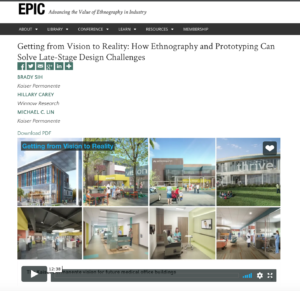Category: Uncategorized
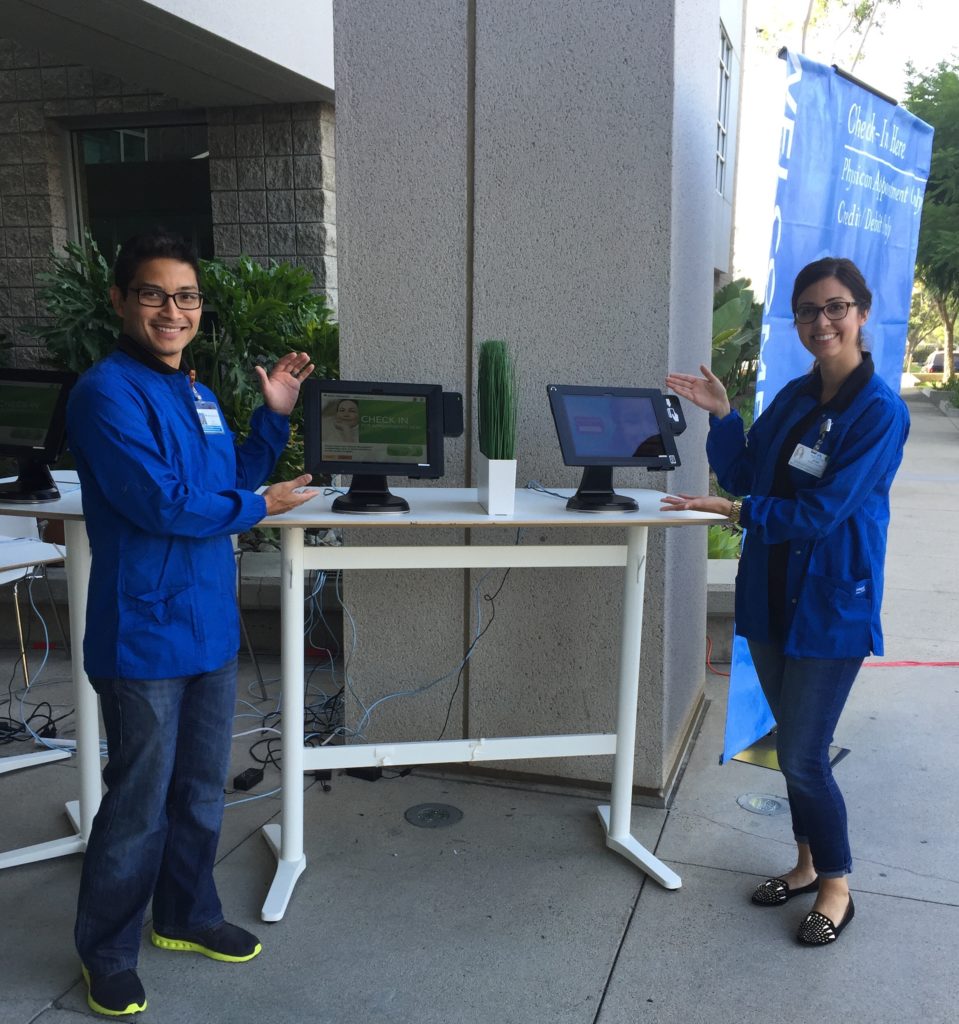
Winnow Research was thrilled to work with a large, cross-functional team at Kaiser Permanente to shape the “lobby of the future” for very soon-to-be-built medical buildings in Southern California. At the EPIC Conference (Ethnographic Praxis in Industry) last October Hillary Carey and Brady Sih presented a piece of the project focused on the conference theme of “evidence.” We talked about how the tangibility of the full-scale, working prototypes helped team and leadership who normally work in silos, and from their functional expertise, collaborate on new solutions through user-centered design.
To understand the future vision for the lobby experience, we followed a familiar set of steps for user-centered design projects:
- Observe: current patient and worker experience.
- Rough prototypes: Bodystorm with minimal props and in a simulation space (Oulasvirta 2003).
- Working prototypes: Transform a current, working medical facility into the format of the future buildings. We brought in new furniture, signage, and technology to the building and coached the staff to work in new ways.
In this way, we practiced new roles and explored multiple solutions before we worked up to pressure-test our best ideas with staff who had urgent jobs to do and patients who were most concerned with getting to their appointments on time.
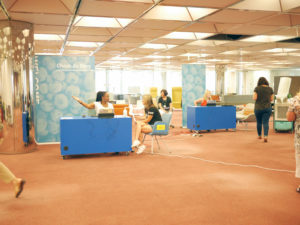
What this project showed us— as a healthcare organization and as design and ethnography practitioners—is that with a growing emphasis on merging digital and physical experiences, there is also a growing need to use ethnography and prototyping to ensure user needs are front and center at every stage of facility design and implementation. These methods to study user experience are particularly important during implementation when multiple systems are being resolved and information is needed about how they will influence each other.
You can read the conference paper here: https://www.epicpeople.org/ethnography-prototyping-late-stage-design/
And if you are an EPIC People member, you can watch the presentation we gave at the conference.
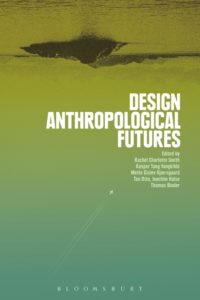
(2016) Edited by Smith, R.C., Vangkilde, K.T., Kjaersgaard, M.G., Otto, T., Halse, J., Binder, T., Bloomsbury
Hillary is reviewing this book because it is an approachable and inspiring academic collection of essays, case studies, and reflections on the emerging field of Design Anthropology. It pushes further beyond the techniques and methods of the first, seminal book to introduce the practice in 2013, “Design Anthropology: Theory and Practice.” Here many of the same contributors dive deeper into the concept of “future” or “multiple futures,” a concept which they propose to be more accurate. This collection shows us that Anthropologists can integrate the collaborative making aspects of Design to move beyond observation of the current state of a society or system and begin to understand what may be possible, plausible and preferable in the future. The editors offer, “The approaches presented in this volume are acutely attuned to political issues, socio-economic differences and their effects on future-making practices in situated contexts.” Illustrating how the sensitivities of Anthropological ways of knowing can strengthen our perspectives on how co-designed futures are received by those who interact with them in context.
As a practicing design researcher/design thinker in industry, I find this book to be more provocative and philosophical than “Design Anthropology.” The older book was a thoughtful take on how to bring more Anthropological practice into any Design Research practice to level-up your skills. “Design Anthropological Futures” is a handbook for those who are already working on exploring and shaping the future. In Chapter 6, Halse and Boffi describe their methods in this way, “Interventionist speculation blends the techniques of invention with techniques of description; it carries an attitude that oscillates between ‘what is’ and ‘what could be’ (p. 89).” For me, this book is exciting in its thoughtful examination of how to explore future experiences that are more daring and complex than what applied Anthropology is typically working with, and more situated and politically-aware than what Design methods typically extend to. This, to me, is the next generation of tools for exploring big questions in holistic contexts.
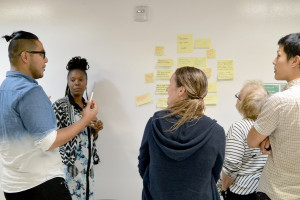
Carnegie Mellon’s School of Design is proposing a new type of Designer, a new practice for working toward significant, complex issues: Transition Design. I think it’s especially relevant today because the current presidency is shining a light on so many social problems that are not on a healthy trajectory within the U.S. and this administration also manages to challenge any improvements to climate change and other environmental concerns.
In many ways, Transition Design builds on Service or Systems Design and Social Innovation. But what I’m fascinated by is that they aren’t taking the Human Centered Design tools that are familiar to us. They are proposing new tools, new mindsets, and new references to prepare students for truly wicked problems.
From the paper, “Transition Design Overview” by Irwin, Kossoff, and Tonkinwise,
“ The transition to sustainable futures calls for new ways of designing that are based upon a deep understanding of how to design for change and transition within complex systems (Irwin 2011). This knowledge and the new skillsets it will inform must be integrated from areas such as science, philosophy, psychology, social science, anthropology and the humanities and will therefore challenge existing design paradigms.”
https://www.academia.edu/13122242/Transition_Design_Overview
From Cameron Tonkinwise’s entertaining and challenging Medium post, “design thinking, yet again, because, maybe, it could actually be useful, perhaps even necessary, given every thing”
“We are not adequately seeing all these sociotechnical systems. We are missing the designed relations between these systems and our various habits and values that are proving so resistant to change toward more sustainable futures.”
https://medium.com/@camerontw/design-thinking-yet-again
Terry Irwin, Gideon Kossoff, and Cameron Tonkinwise boldly propose that in order to make a dent in these intractable problems, Designers of the Future will need new skills, postures, and foundations apart from traditional design practice, such as:
- Choosing a theme-based career, to stay with problems over time and across disciplines. An avocation, not a vocation.
- Developing less through individual creativity, and more relational discovery (talking to people, learning from experts, pulling in multiple types of information).
- Fostering criticism and resistance. These are activists they are raising over there. Resist the zero-sum, capitalistic drivers.
- More academic learning about theories of change and philosophy of mindsets and belief systems.
- Visioning at significant, long-term levels: radical visions of 2020, 2050 and 2100—because these are the timelines needed to solve many of the wicked problems.
- Therefore, Learning to plan a long-term project. You will only be part of a relay race, not a sprint.

